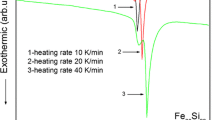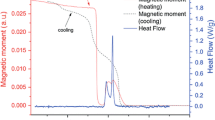Abstract
In order to determine the mechanism of plastic deformation, the hardness and local plasticity of amorphous Fe78P20Si2 alloy are compared at different stages of its crystallization activated by thermal treatment at 300–750°C or short-term photon treatment with a radiation dose coming to the sample of 10–60 J/cm2. The phase composition and structure were investigated by X-ray diffractometry and high-resolution transmission electron microscopy. With the same sequence of structural changes, the crystallization rate under photon treatment is more than two orders of magnitude higher than that under thermal treatment, which indicates the effect of a high rate of input of the process activation energy. The nonmonotonic dependence of the hardness, elastic modulus, and the proportion of plastic strain in the indentation work is found, depending on the annealing temperature or radiation dose received by the sample, as a result of structural changes in the alloy. The local plasticity of the initial alloy and fully crystallized alloy are close in magnitude. Based on the features of the crystal structure of the Fe3P phase (the impossibility of the dislocation mechanism of plastic deformation) and assuming that the structural unit (tetrahedral Fe3P cluster) of the crystallized and amorphous alloy is identical, a conclusion was formulated about the cluster mechanism of plastic deformation of the amorphous alloy.











Similar content being viewed by others
Notes
Within the scope of the article, it should be noted that both fused quartz and sodium silicate glass have a significant proportion of the plastic component in the nanoindentation deformation work [9].
Weak translational symmetry of crystalline hydroxyapatite eliminates the formation of dislocations of deformation origin.
REFERENCES
C. A. Schuh, T. C. Hufnagel, and U. Ramamurty, Acta Mater. 55, 4067 (2007).
A. S. Argon and H. Y. Kuo, Mater. Sci. Eng. A 39, 101 (1979).
D. Srolovitz, V. Vitek, and T. Egami, Acta Met. 31, 335 (1983).
J. S. Langer, Scr. Mater. 54, 375 (2005).
M. H. Cohen and D. Turnbull, J. Chem. Phys. 31, 1164 (1959).
F. Spaepen, Acta Met. 25, 407 (1977).
A. S. Bakai, Policluster Amorphous Bodies (Energoatomizdat, Moscow, 1987) [in Russian].
Institute of Silicate Chemistry of RAS – 80 Years. Historical Essays, Ed. by V. Ya. Shevchenko (Art-Ekspress, St. Petersburg, 2016) [in Russian].
Yu. I. Golovin, Nanoindentation and its Capabilities (Mashinostroenie, Moscow, 2009) [in Russian].
A. V. Evteev, A. T. Kosilov, and E. V. Levchenko, in Proceedings of the Conference on Amorphous Precision Alloys (Moscow, 2000), p. 62.
V. M. Ievlev, A. V. Kostyuchenko, B. M. Darinskii, and S. M. Barinov, Phys. Solid State 56, 321 (2014).
V. M. Ievlev, S. M. Barinov, V. S. Komlev, A. Y. Fedotov, and A. V. Kostyuchenko, Ceram. Int. 41, 10526 (2015).
https://materials.springer.com/isp/crystallographic/docs/sd_0452183.
S. Huang, Structure and Structure Analysis of Amorphous Materials (Clarendon, Oxford, 1984).
G. E. Abrosimova, A. S. Aronin, and N. N. Kholstin, Phys. Solid State 52, 445 (2010).
W. C. Oliver and G. M. Pharr, J. Mater. Res. 7, 1564 (1992).
M. C. Antonova, E. K. Belonogov, A. V. Boryak, V. V. Vavilova, V. M. Ievlev, S. V. Kannykin, and N. A. Palii, Inorg. Mater. 51, 283 (2015).
A. M. Glezer, Melt-Hardened Nanocrystals (Fizmatlit, Moscow, 2012) [in Russian].
ACKNOWLEDGMENTS
The authors are grateful to G.V. Afonin (Voronezh State Pedagogical University) for his assistance in conducting the study.
Funding
This work was supported by the Russian Foundation for Basic Research, project no. 1703-01140 A. The scientific equipment of the Center for Collective Use of the Voronezh State University was used.
Author information
Authors and Affiliations
Corresponding author
Ethics declarations
The authors declare that they have no conflict of interest.
Additional information
Translated by O. Zhukova
Rights and permissions
About this article
Cite this article
Ievlev, V.M., Kannykin, S.V., Il’inova, T.N. et al. Microplasticity of Amorphous and Crystallized Fe78P20Si2 Alloy. Phys. Solid State 61, 1231–1238 (2019). https://doi.org/10.1134/S1063783419070114
Received:
Revised:
Accepted:
Published:
Issue Date:
DOI: https://doi.org/10.1134/S1063783419070114




